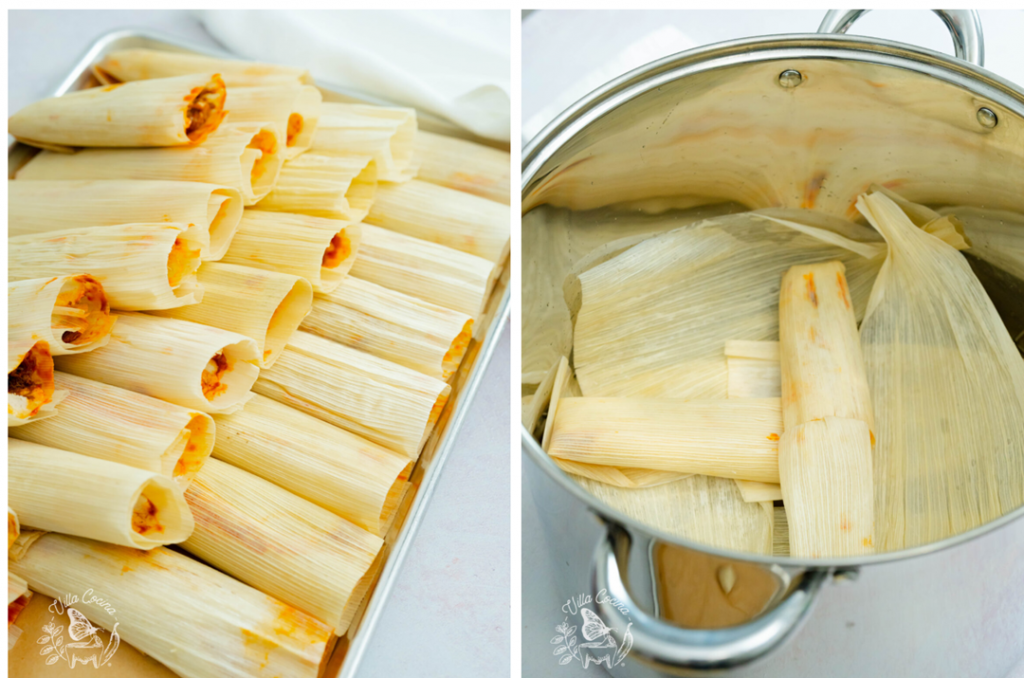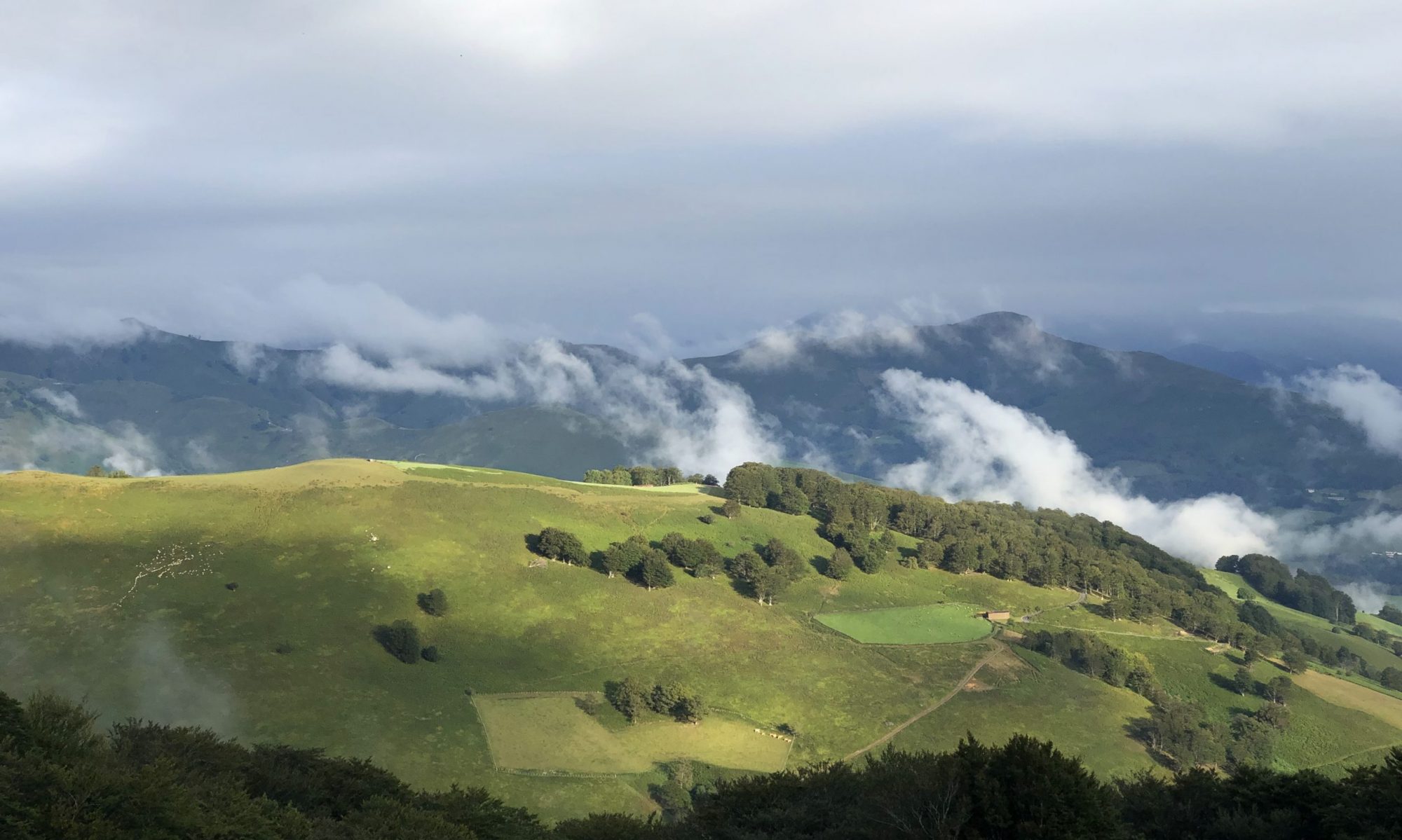Ingredients
Pork shoulder (Boston butt) is the ideal choice for tamales due to its rich marbling of fat, which adds flavor and keeps the meat moist and tender. This cut is also an affordable option that benefits from long, slow cooking.
White onion adds a subtle sweetness, while garlic brings a distinctive sharpness. When cooked together, they form a rich flavor base.
Bay leaves bring earthy tones, while Mexican oregano adds a floral, earthy depth. Cumin seeds lend warm, nutty, and smoky notes, complemented by a slight kick from black pepper. Together, these aromatics enhance and deepen the dish’s flavor profile.
Guajillo chiles are mild in heat with subtle flavor, making them a perfect pairing for the smoky, slightly sweet, and dried fruit-like notes of ancho chiles. Meanwhile, chile de árbol adds a sharp kick of heat, making it the spiciest pepper in this mix.
Corn masa harina is a type of flour made from dried corn kernels that have been soaked in a lime solution until soft, then ground into a fine powder. Note that it’s referred to as corn flour, but it’s not the same as cornmeal.
Baking powder helps soften the masa and creates a slightly lighter texture with a small rise, resulting in a less dense, more tender dough.
Pork lard brings a rich, traditional pork flavor, while shortening offers a neutral taste. Together, they create a balanced flavor, resulting in tamales that are moist and tender.
Corn husks play a crucial role in tamales by wrapping and shaping the masa and filling, helping to retain moisture. Beyond their functional use, these husks impart a delicate, earthy flavor.
Tips from Comments
you can freeze them raw , a dozen at a time and store them in a gallon size freezer baggie . So when you feel like eating tamales , just steam them frozen , it will take longer to cook , maybe a half hour more. They will taste like you just made them that day
Grocery List (for a double recipe)
4 lbs pork shoulder Boston butt boneless
2 lb chuck roast
White onion – 2
Bay leaf – fresh 4
Peppercorns – whole
Guajillo chilies – 16 large
Ancho chilies – 4
Chiles de árbol – 8
Cumin – whole
12 cups masa harina
Organic pork lard
Vegetable shortening
Corn husks – 60
Red Pork Tamales
Recipe Makes 23-24 tamales
Ingredients
2 lbs pork shoulder Boston butt boneless ☞
Aromatic for broth
1/2 medium, white onion
4 garlic cloves, whole
2 bay leaf :
2 tsp salt, kosher
1/2 tsp dry oregano
1/2 tsp black peppercorns, whole
10-12 cups of water ☞
For browning
2 TBSP of oil
For the guajillo sauce
8 large guajillos
2 ancho chiles
4 chiles de arbol
1/4 medium white onion, sautéed
Molcajete
2 garlic cloves
1/2 tsp salt, kosher
1/2 tsp cumin, whole
2 TBSP water ☞
Additionally for sauce
2 cups broth to rehydrate chilis
1 cup of broth pour into blender to get the last bit of chili sauce
1 TBSP oil to fry the sauce
Season sauce to taste, I did 3/4 tsp Note: remember the broth also has salt
For the masa dough
6 cups masa harina
1 tsp baking powder
Organic pork lard
1/2 cup packed vegetable shortening
1 1/2 tsp salt, kosher
3 2/3 cup of broth
32-35 Corn Husks
How to Make Tamales
Cooking the Pork
Heat oil in a large pot over medium heat.
Sauté onion wedges until softened, then remove and reserve. Adjust the heat to medium-high.
Brown the pork in batches, turning each piece to ensure even coloring on all sides and to avoid overcrowding the pot.
Add 10 cups of water and return the browned pork to the pot.
Stir in the aromatics and salt.
4 garlic cloves
½ tsp whole black peppercorns
½ tsp Mexican oregano
2 tsp kosher salt
½ med white onion (don’t slice)
2 fresh bay leaves
(Bring to a boil, then reduce to a gentle simmer over medium-low heat. Cover and cook for 2–2.5 hours, or until the meat is fork-tender.
Shred the meat and strain the broth, reserving both for later use.

Chile Sauce
Remove the seeds of 8 chilies guajillo.
Remove the seeds of 2 dried ancho chilies.
Toast the guajillo, ancho, and arbol chilis on a comal (or cast iron skillet) over very low heat until fragrant, turning constantly to prevent them from burning.
Then toast 4 dried chilies de árbol. Remove from heat when lightly toasted.
Set the peppers aside until we need them.
Rinse the peppers and transfer them to a heatproof container. Pour 2 cups of the reserved hot broth over the chiles to rehydrate, and let them sit for about 5 minutes, or until softened.
Molcajete : Grind and mash two fresh garlic cloves, ½ tsp whole cumin, and one tsp of kosher salt into a paste, then loosen it with 2 tablespoons of water. Transfer to a small container and set aside until needed.
Transfer the rehydrated peppers to a blender along with the broth and the sautéed onions (the ones cooked before browning the meat
Blend until smooth, then strain to remove any large pieces of chili skin if necessary.
Heat 1 tablespoon of oil in a large pot over medium-low heat. Carefully pour in the sauce and stir. Pour the remaining 1 cup of broth into the blender, swirl to capture any leftover sauce, and transfer it to the pot.
If you used the molcajete, add the paste now and stir it into the sauce. Let it simmer gently for 5-10 minutes.
Add the shredded meat and allow it to heat through. Then, mix in the salt to taste (about 3/4 tsp kosher). Remove from the heat and let it cool.


Corn Husk
Sort through the husks, selecting medium to large ones without holes or dark spots. Any imperfect ones can be used later, when cooking.
Submerge the husks in warm to hot water for 15–30 minutes, or until softened. Rinse, remove any corn silk, drain, and transfer to a container.
Masa – Dough
In a large bowl, whisk together the lard and shortening until smooth, light, and fluffy, about 2–3 minutes.
In a separate bowl, mix together the corn masa harina, (Instant corn masa) baking powder, and kosher salt until evenly distributed.
Add the masa mixture in two parts, kneading between each addition until the lard is fully incorporated and it reaches a crumbly consistency.
Gradually add the broth, kneading the dough after each addition, until it reaches a soft, fully moistened texture that holds its shape. The amount of broth required may vary depending on its temperature.
Moisture is essential for soft tamales, but keep in mind that the dough should be soft, not stick to your clean hands, and hold its shape when molded.
Cover the dough with a kitchen towel to prevent it from drying out. If it does, add more broth to achieve the right consistency.
How to wrap

Step 1:
Grab a husk, shake off excess water, and lay it on a flat surface. We are using the smooth side of the leaf.

Step 2:
Grab some of the dough, form into a ball, then flatten into a disk. Place on the center of the husk.

Step 3:
Spread in all directions.

Step 4:
Leave some empty space on both sides of the leaf and bottom wide end. Stop a little over midway when spreading toward the narrow top. In thickness we are looking for a little over an 1/8 in.

Step 5:
Spoon in the cooled filling. Be generous but make sure you can close the tamal. .

Step 6:
Fold one end over to the opposite side and gently press to secure.

Step 7:
Peel the husk away.

Step 8:
Fold over the opposite side and press lightly.

Step 9:
Tuck the edge of the husk. Roll towards the opposite end to fully wrap the tamal.

Step 10:
Feel where the masa ends at the top and fold downward. This flap should remain under, in order to keep the tamal closed at all times
Step 11:
Lightly press the bottom. Assemble the rest of the tamales by following the same steps. Arrange on a sheet pan, in an angle, open side up.
Cook the Tamales
Use a large steamer pot and add enough water to reach just below the rack, ensuring it doesn’t touch the tamales while cooking.
Arrange three tamales in a “T” shape, with the open ends facing inward to create a stable base.

Arrange the remaining tamales around the base, open ends up. Cover with the imperfect husks to prevent water from getting in.

Let the water come to a boil over medium-high heat. Then, cover the pot, lower the heat to medium-low, and simmer gently for 50 minutes to 1 hour 10 minutes, or until the dough is fully cooked.
Add more water to the bottom of the pot if it’s running low.
Remove a tamal from the pot and let it cool for 5-10 minutes before unwrapping. If it releases easily from the husk, holds its shape, and doesn’t taste like raw masa, it’s ready. Turn off the heat, and keep the pot covered if not in use.
